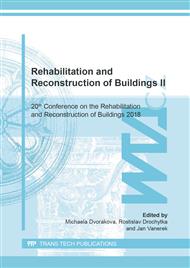p.123
p.129
p.136
p.145
p.153
p.159
p.165
p.172
p.177
Changes in the Crystal Structure of Cement Mortars Subjected to a High Temperature
Abstract:
During the fire, structures of a building are exposed to the effect of a high temperature. As a result, the strength parameters and physical properties of concretes and cement mortars undergo change. Their range depends on the time and temperature of the fire. Describing the changes of the internal structure of concretes and mortars resulting from a fire is important in the fire diagnostics of the structures. The paper presents the results of an original research project, within which there was an attempt to relate changes in mechanical properties of the cement mortars with changes in the crystal structure of cement paste. For this purpose, the authors prepared cement prisms, which were heated at various temperatures that occur during a fire after 28 days of their curing. Then, the samples were subjected to compressive strength tests and tests of a structure and a phase composition using an electron scanning microscope. Scanning microscopy is a precious research method that allows observing surfaces of various materials with magnifications from x50 to even x1000000 at a very big sharpness depth. The tests conducted by the authors showed that the effect of fire and of the gradient of high temperatures on the executed samples causes the deterioration of the cement paste in the form of changes in physico-mechanical properties and in its internal structure. As the temperature increases, the compressive strength of the paste decreases gradually and proportionally. The SEM analysis also showed that the change in the physical parameters of the cement paste is reflected in its phase composition.
Info:
Periodical:
Pages:
165-171
Citation:
Online since:
June 2019
Authors:
Keywords:
Price:
Сopyright:
© 2019 Trans Tech Publications Ltd. All Rights Reserved
Share:
Citation:


